Cycling Through South Africa’s Cape and Winelands
Article and photos
by Lies Ouwerkerk
Senior
Contributing Editor
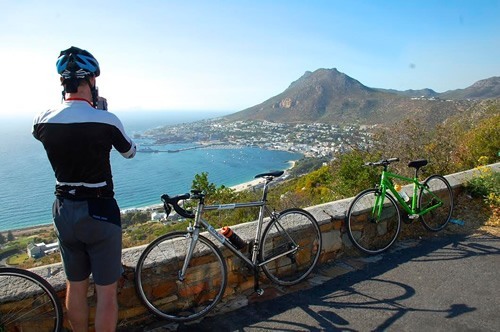
|
|
Cyclist stopping to take a snapshot
of Cape Town, South Africa.
|
The brutal winter had kept North Americans
locked inside their houses for what felt like ages. Being
able to escape that grip of never ending snow and deep freeze,
and embrace the balmy summer temperatures of sunny South
Africa therefore felt like a gift straight from heaven.
And where else would I want to celebrate that than in the
outdoors of the spectacular Cape Peninsula?
So I kick started my South African adventure
with a 12-day cycling ride through the rolling hills of
the Cape Peninsula wine lands and along the dramatic coastlines
of the Atlantic and Indian Oceans, in the company of a guided
group of 10 cyclists hailing from Great Britain, Australia,
and Canada.
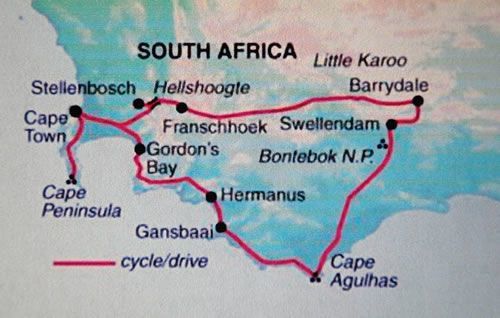
|
|
A map of our 12-day cycling itinerary.
|
The circular route through the southwestern
tip of South Africa also included part of the semi-arid desert
of the Great Karoo, back roads of the more fertile area of
the Little Karoo, the Langeberg Mountains, the Bontebok National
Park, and sleepy old Dutch and French villages along part of
the famous Route 62, a historical route built in the 1920’s
to connect small farming communities with the harbor towns
of Cape Town in the West and Port Elizabeth in the East.
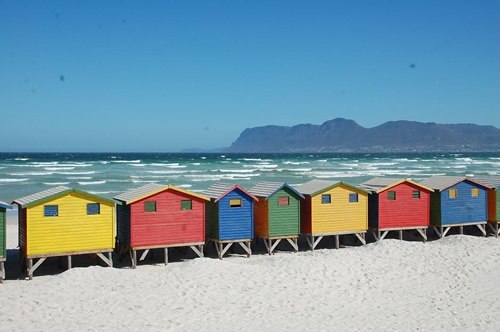
|
|
Iconic beach houses of Muizenberg.
|
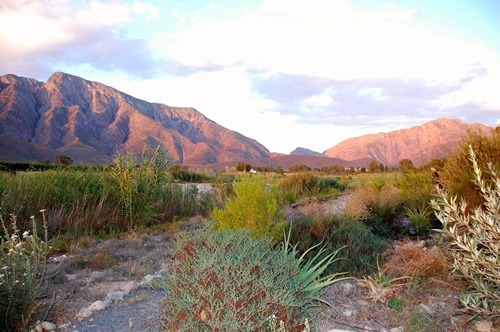
|
|
Backroads of the Little Karoo.
|
Level of Fitness
All participants — from a 22-year-old
university student to a 74-year-old grandmother, and every
age group in between — were in good shape (as was required
by the tour company), although our cycling experience varied
greatly. Some were used to ride long distances in hilly
landscapes on a daily basis, others were serious triathlon
competitors, and again others were just occasional cyclists
and had not touched their bikes since the previous summer.
Some carried their own saddles and pedals, and showed up
in appropriate cycling gear, others bicycled in their ordinary
clothes and footwear.
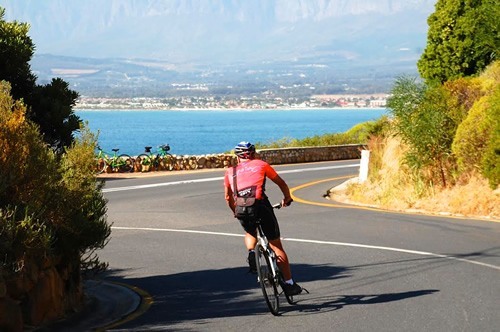
|
|
A cyclist cruises downhill.
|
Nobody in the group brought their own
bicycle. Instead, we all toured on comfortable 9-speed Hybrid
bikes, hired in advance through our tour company for an
extra fee. Luggage was transported by a minivan, also used
to bring up the rear and as emergency backup.
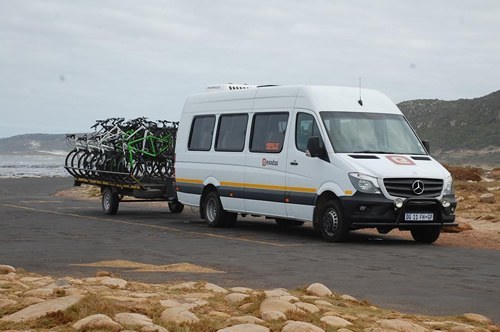
|
|
A van carries luggage and sometimes transports
the bikes from location to location.
|
Originating from The Netherlands and
practically on a bike since the cradle, the prospect of
averaging around 60K (36 miles) a day had not fazed me on
the forehand. However, the reality of cycling the
South African hills proved to be very different from paddling
through the flat Low Lands, especially in high temperatures
and into a strong southeasterly wind!
Luckily, the few diehards among us would
patiently wait on top of each hill for the rest of the group
to arrive, their colorful shirts shimmering in the distance
like a beacon on a mountaintop.
Camaraderie and support among the group
and staff members was indeed exemplary. There was always
someone to reset the height of a saddle, fix a chain that
had fallen off, lend some water if one had run out, provide
some encouraging words to those who felt exhausted, or cheer
on the last ones to arrive at the daily finish.
Wine Tasting
And what memorable finish it was each
day! As soon as we would reach the premises of a designated
wine estate, whether it was in Stellenbosch, Franschhoek,
Paarl, Barrydale, or any other place along the wine route,
our focus would immediately shift to wine tasting. Instantly
forgotten would be calf cramp, saddle pain, sunburn, and
fatigue!
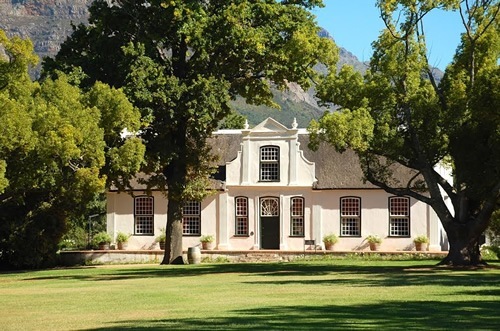
|
|
A wine estate.
|
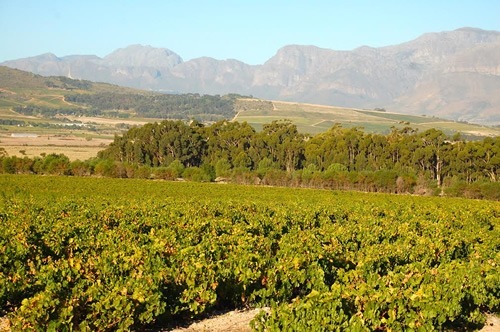
|
|
The estate vineyard.
|
Seated at tables, on bar stools, or
under centuries old trees on the lawn of a wine estate,
we would taste five or six different wines, typically starting
with whites such as Sauvignon Blanc or Chardonnay, then
changing to reds such as Merlot, Shiraz, or Cabernet Sauvignon.
At last, we would top it off with a sweet desert wine: a
red port, or a white Muscadel. The latter was replanted
after Apartheid, when South Africa emerged from isolation,
but had actually already been used for the first South African
wine ever made, in 1659.
The deep red, smoky Pinotage was undoubtedly
one of my favorites. This red wine grape was bred in South
Africa in 1925 by viticulture professor Perold at the Experimental
Farm of the Stellenbosch University as a cross between Pinot
Noir and Hermitage varieties, and eventually rose to great
fame in postwar years.
While Pinotage makes up a mere 6% of
South Africa’s vineyards, it is considered the country’s
signature grape variety, as it is hardly grown anywhere
else in the world.
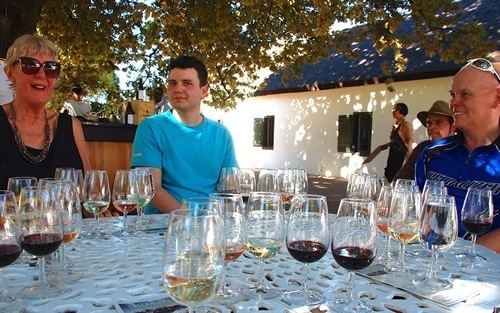
|
|
Wine tasting at the estate.
|
Other Attractions and Highlights
It was not only about cycling and wine
on this tour around the Cape, though.
At Cape Argulhas, the southernmost tip
of South Africa where Atlantic and Indian Oceans meet, we
strolled along the boardwalk through rocks and sand dunes,
and visited the lighthouse, presiding over a coastline where
many tragic shipwrecks had taken place and numerous traders
and adventurers had lost their lives in past centuries.
At the Cape of Good Hope, once called
the Cape of Storms, we hiked through the scenic Cape Point
Nature Reserve and spotted a great variety of animals, among
them ostriches, bonteboks, antelopes, and baboons.
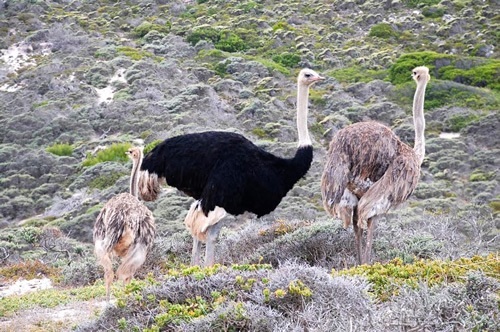
|
|
Ostriches sighted at the Cape Point Nature Reserve.
|
We also hiked through Bontebok National
Park in the foothills of the majestic Langeberg Mountains.
Although this park was originally established to ensure
the preservation of the bontebok, we learned a lot about
some of the many varieties of grasses and other plants (about
9,000 species) in the endangered fynbos, including
several that are not found anywhere else in the world, such
as the King Protea, the national flower of South Africa.
In Hermanus, a picturesque coastal town,
famous for whale watching during the southern winter and
for world’s only whale crier, we enjoyed one day of complete
rest, halfway the tour, on one of its sandy beaches.
At Boulder Beach, near Simon’s Town,
we watched a colony of over 2,000 African penguins — from
strategically built boardwalks — wandering freely in
their habitat of wind-sheltered coves, bays, and beaches.
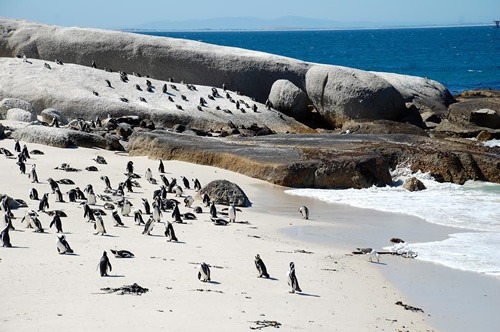
|
|
Penguins wandering freely on the beach, sometimes
pairing as below.
|
Every year between October and January,
adult penguins replace their worn-out feathers by brand-new
ones, and are in that period unable to hunt for fish and
feed their young; and each year, the organization Sanccob rescues
hundreds of these chicks from starvation, to rehabilitate
them and eventually release them back into the wild, in
that way saving the dwindling population of this endangered
species, the only penguins endemic to the African continent.
Eating and Lodging
Because of its location between two
oceans, fertile farmlands, animal diversity, and many different
culinary influences, the Cape Peninsula is notorious for
its excellent, highly varied kitchen, and we certainly had
a chance to sample its riches!
In areas where we had limited or no
access to restaurants, our tour leaders did an excellent
job preparing us lunches and dinners like braai (BBQ),
Malay curry, fish and chips, or fresh salads.
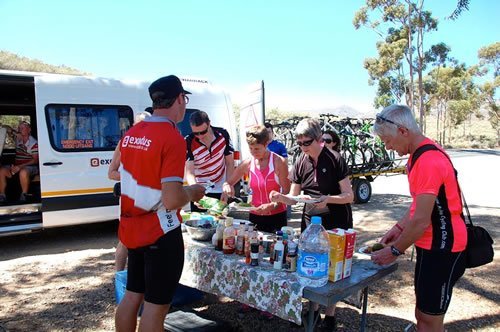
|
|
A roadside meal prepared by the tour leaders.
|
Along the coast, we had opportunities
galore to eat our heart out on fish and seafood, pulled
fresh from the ocean: Cape salmon, tuna, hake, kingklip,
yellow tale, crayfish, peri-peri prawns, and squid, for
instance.
In Cape Town and the wine lands, we
also tried wild game meat such as kudu, ostrich, springbok,
warthog, and crocodile.
At the end of each day, we ended up
in cozy and comfortable guesthouses and B&Bs, where
healthy and hearty breakfasts were served to ensure enough
energy for cycling yet another 60K.
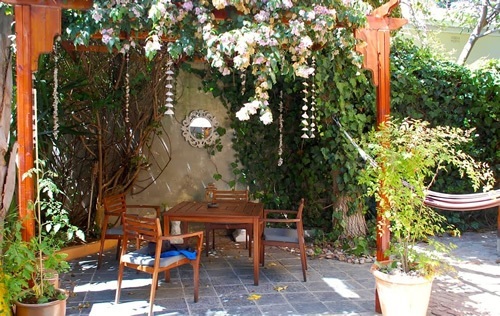
|
|
A typical guesthouse, usually with a great view.
|
Completing the Circuit
The most scenic route was reserved for
the last day of our tour, and coincided with part of the
Cape Argus route, one of the largest cycling events in the
world. Via the spectacular Chapman’s Peak, we cycled through
picturesque Hout Bay, Llandudno, and Camp’s Bay, back to
our accommodation in Cape Town.
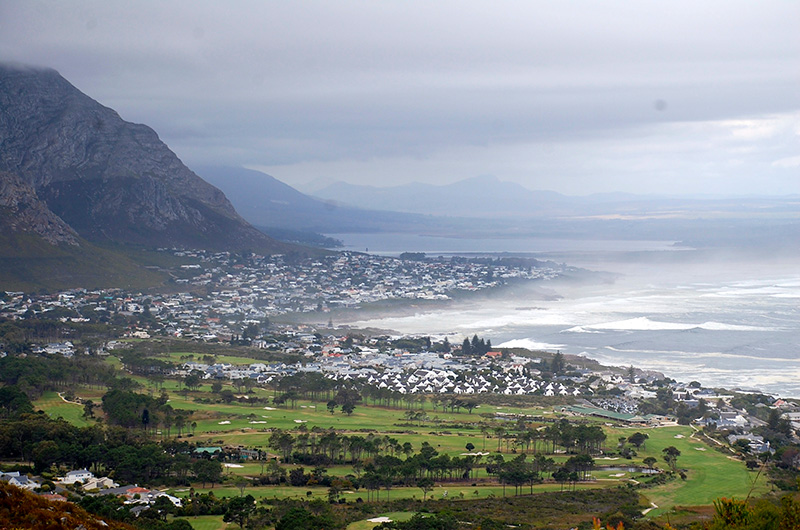
|
|
View of Hout Bay.
|
Before saying our goodbyes, however,
we first headed with some bottles of champagne to the top
of Signal Hill — a famous spot for sundowners — to
celebrate our great achievement, and then danced the night
away on the African beat of a live band.
But the next morning, we finally could
surrender our sore and fatigued bodies to a well-deserved
and highly needed rest.
Additional Trip Notes
-
The cycling tour was organized
by EXODUS and
was rated "moderate"
-
Tours take place in South
Africa’s spring, summer, and fall months, between
August and April
-
We biked on good quality
tarmac roads with little to moderate traffic,
but there were no specific bicycle paths
-
In South Africa, wearing
a helmet is mandatory, and one drives on the
left side of the road
|
Lies
Ouwerkerk is originally from Amsterdam,
The Netherlands, and currently lives in Montreal,
Canada. Previously a columnist for The Sherbrooke
Record, she is presently a freelance writer and
photographer for various travel magazines.
|
